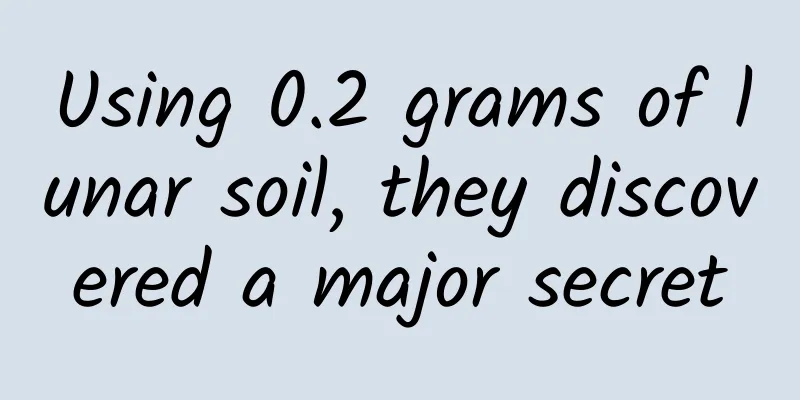Using 0.2 grams of lunar soil, they discovered a major secret

|
When conducting the first experiment with lunar soil, weighing 0.02 grams, Nanjing University professor Yao Yingfang was so nervous that his hands were shaking. His research is to use some components in the lunar soil as artificial photosynthesis catalysts to convert carbon dioxide exhaled by humans, water mined from the lunar surface, etc. into oxygen, hydrogen, methane and methanol. If we can master this skill, even without supplies from Earth, humans can use local materials on the moon to produce oxygen, water and other things necessary for survival. It can help humans build lunar bases and lunar relay stations, and provide energy supplies for more distant space exploration and interstellar travel. Recently, a research team led by Academician Yang Mengfei, chief commander and chief designer of the Chang'e-5 probe system of the China Academy of Space Technology, Academician Wang Weihua of the Institute of Physics of the Chinese Academy of Sciences, and Academician Zou Zhigang of Nanjing University proposed a strategy for artificial photosynthesis on the moon. The research results were published in the international authoritative journal Joule. (Copyrighted image from the gallery, no permission to reprint) Screening out two methods to achieve efficient catalysis of lunar soil In order to live and survive on the moon, water, oxygen and energy are essential. Relying on the earth to supply them is always a drop in the bucket. Researchers hope to find more possibilities from the "indigenous" resources of the moon. Two years ago, NASA announced that there were water molecules on the surface of the moon. The Chang'e-5 probe launched by my country conducted in-situ detection of lunar soil, which further confirmed the existence of water resources on the moon. Water can not only be used as drinking water for astronauts, but can also be converted into two treasures. "We participated in a project led by the Qian Xuesen Space Technology Laboratory of the China Academy of Space Technology in the early stage, called the exploitation and photochemical conversion of water resources on the lunar surface, that is, decomposing water into hydrogen and oxygen," said Yao Yingfang, the first author of the paper, in an interview with China Science Daily. After obtaining the lunar soil brought back by Chang'e-5, the team particularly wanted to see whether the lunar soil could also be used as a catalytic material to convert water into hydrogen and oxygen, and whether the lunar soil could play a certain role in the conversion of carbon dioxide. The lunar soil obtained this time is very young basalt on the lunar surface. This mineral is rich in iron, titanium and other catalyst components commonly used in artificial photosynthesis. "We analyzed about 24 mineral components in the lunar soil through machine learning and other methods, among which 8 components such as ilmenite, titanium oxide, hydroxyapatite, and various iron-based compounds have good photocatalytic properties." Yao Yingfang introduced. Moreover, the lunar soil surface itself has abundant micropores and vesicle structures, which can further improve the catalytic performance of the lunar soil. It is very rare to find these naturally existing advantages in the lunar soil. In order to find the best solution, the research team conducted various attempts on lunar soil catalysis to evaluate its performance, such as using photovoltaic electrolysis of water to achieve the conversion of hydrogen and oxygen; photocatalytic decomposition of water into hydrogen and oxygen; photocatalytic conversion of carbon dioxide into carbon monoxide, methane and methanol; and photothermal catalytic hydrogenation of carbon dioxide to produce methane and methanol. In the end, they selected photovoltaic water electrolysis and photothermal catalytic carbon dioxide hydrogenation as two methods that can achieve the highest lunar soil catalytic efficiency, and the resulting materials are more useful and purer. "Methane, as a fuel, is a very good spacecraft propellant; methanol has even wider uses. Many organic compounds we wear and use contain methanol as a raw material. The continuous production of methanol means that we can build a methanol chemical plant on the moon to produce the chemicals needed by humans," said Yao Yingfang. The four substances, oxygen, hydrogen, methane and methanol, obtained by catalysis of lunar soil are all necessary for human survival on the lunar surface and the construction of bases and relay stations. As one of the most abundant resources on the moon, lunar soil resources have huge development space and potential. In-situ, significantly reducing launch load and cost Before this, scientists have proposed many strategies for extraterrestrial survival, but most designs rely on energy from Earth. For example, the Mars Oxygen In-Situ Resource Utilization Experiment (MOXIE) carried by NASA's Perseverance Mars rover launched in 2020 can produce oxygen from carbon dioxide in the Martian atmosphere, but the instrument is powered by isotope batteries from Earth and uses electrochemical methods under high temperature conditions to decompose carbon dioxide into carbon monoxide and oxygen. "The standard they designed at the time was to achieve an oxygen conversion efficiency of 10 grams per hour, but for various reasons, they ultimately achieved a conversion efficiency of about 6 grams per hour on the surface of Mars," Yao Yingfang said. "Not only is the efficiency not high, but the device is said to be very bulky and it is likely that the battery will need to be replaced frequently, which means that the spacecraft will have to be launched many times, and each launch will greatly increase the payload." The extraterrestrial artificial photosynthesis technology described in this paper is relatively simple, and it completely utilizes extraterrestrial resources and environment to produce oxygen, fuel and survival supplies. The temperature on the moon at night is minus 173 degrees Celsius, and carbon dioxide turns into dry ice at minus 78.5 degrees Celsius. Therefore, during the night on the moon, carbon dioxide can be directly separated from the gas exhaled by humans, and then decomposed into hydrogen and oxygen using water resources mined on the moon's surface. Oxygen is for human breathing, and carbon dioxide is put together with hydrogen. During the day, when the temperature on the moon is as high as 127 degrees Celsius, the process of converting carbon dioxide into methane by adding hydrogen can be cleverly realized in situ. "The biggest advantage of doing this is that it can significantly reduce the rocket launch payload, reduce the cost of spacecraft flying to the moon and even farther into outer space, and achieve affordable and sustainable deep space exploration," said Yao Yingfang. Analogous to the Age of Exploration, the world has reached a consensus that we will enter the Age of Spaceflight in the near future. Moreover, there are already people exploring space, such as Musk's SpaceX and Amazon founder Jeff Bezos. Our country has even proposed to build an Earth-Moon space economic zone. Bao Weimin, an academician of the Chinese Academy of Sciences and the International Academy of Astronautics, once estimated that by 2046, our annual total output value in the Earth-Moon economic zone will reach at least US$10 trillion. "If we want to conduct large-scale exploration of extraterrestrial worlds, we must rely as little as possible on Earth's supplies and instead use extraterrestrial resources to realize an extraterrestrial recycling system, so that we can truly realize the Earth-Moon space economic zone." Yao Yingfang said, "Our strategy is to provide a 'zero-energy' life support system for a sustainable and affordable extraterrestrial living environment." One gram of lunar soil is precious July 12, 2021 is destined to be a day that Yao Yingfang will never forget. On this day, he went to the Lunar Exploration and Space Engineering Center of the National Space Administration with Academician Zou Zhigang to watch the lunar soil distribution ceremony. At the same time, as a member of the joint research team of the China Academy of Space Technology, the research team of Nanjing University conducted research on 1 gram of lunar soil. "The whole process from beginning to end excited me! Before this, I never thought that I would join such a glorious team, and we are the only joint research team among the first batch of 13 scientific research units that distributed lunar soil that used materials, catalysis and energy as entry points." Yao Yingfang still feels excited every time he thinks of that moment. Although the lunar soil used for research this time is only 1 gram, it is extremely precious. You should know that the lunar soil brought back from the moon by the Apollo mission of the United States and given to Chinese leaders as a state gift was only 0.5 grams. The Chang'e-5 lunar soil samples stored in the lunar sample laboratory of Nanjing University. Photo by Xinhua News Agency reporter Chen Xiyuan After the lunar soil was brought back to Nanjing University, it was stored in an ultra-clean environment tailored for it by the school. The environment was designed strictly in accordance with the "Lunar Sample Use Regulations" issued by the National Space Administration. The oxygen content is not higher than 20ppm (parts per million) and the water vapor content is not higher than 50ppm. At the same time, the storage space must be monitored continuously and with zero blind spots, and real-time audio and video recording and text records must be made during the experiment. Yao Yingfang still clearly remembers the first time he used 0.02 grams of lunar soil. A funny thing happened at that time. Yao Yingfang wanted his students to start this sacred moment, but they were too excited to do it. He was also very nervous when he personally weighed 0.02 grams of lunar soil. "When I was weighing 0.02 grams of lunar soil, my hands were shaking with nervousness. The lunar soil is so precious." Lunar soil is hard to come by, and its first stop was the Environmental Materials and Renewable Energy Research Center of Nanjing University because there is a well-known extraterrestrial artificial photosynthesis research team here, which brings together the country's top talents in extraterrestrial artificial photosynthesis. The team includes not only Academician Zou Zhigang, but also Academician Wang Weihua from the Institute of Physics, Chinese Academy of Sciences, and Academician Yang Mengfei, commander-in-chief and chief designer of the Chang'e-5 probe system of the China Academy of Space Technology. The three academicians jointly established the Academician Studio of Physical and Chemical Processes of Extraterrestrial Survival at the China Academy of Space Technology. "It is thanks to this studio that we have the opportunity to obtain such precious lunar soil. 0.2 grams of it was used in this research," said Yao Yingfang. This research was completed by Nanjing University in collaboration with the China Academy of Space Technology, the Chinese University of Hong Kong (Shenzhen), and the University of Science and Technology of China. Throughout the research process, the team members were very united and motivated, reporting and communicating on the research process and progress every month. More importantly, they also tried their best to protect the originality of the lunar soil during the research and minimize the loss caused by the research process. Yao Yingfang revealed that they are looking for opportunities to test the system in space, possibly for verification in conjunction with China's future manned lunar mission. Related paper information: https://doi.org/10.1016/j.joule.2022.04.011 Author: Zhang Qingdan Source: China Science Daily |
>>: Secret eavesdropping, targeted promotion...are they all true?
Recommend
How much is the price for being an agent of Wuhai Musical Instruments Mini Program? Wuhai City Musical Instruments Mini Program Agent Price Inquiry
How much does it cost to be an agent of the music...
How much does it cost to produce the Tianjin Automobile Mini Program? Tianjin Automobile Mini Program Production Price Inquiry
Mini programs provide convenience for publicity a...
What are those random things you see during a migraine?
Leviathan Press: When I was a kid, I would always...
"91 Ten Articles" - A daily must-read briefing for the new energy vehicle industry (210125)
1. China National Energy Group, China Reform Hold...
Which is the coldest planet in the solar system? Where is the coldest place in the universe?
Curious children ask: What is the coldest planet ...
Which is more secure, Android or iOS? The turning point seems to be approaching...
In fact, objectively speaking, the result of a ga...
How often should you replace your mobile phone? An experienced technician explains it very straightforwardly
The performance, appearance and advanced technolo...
Reno: OPPO's new breakthrough, the side-rotating camera is just the beginning of surprises
As an electronic consumer brand dedicated to maki...
The products exposed on 315 are really deadly if they are fake! Don’t take it lightly!
A type of glass called fireproof glass was expose...
Menopause occurs in both men and women? How to adjust your diet? What should you pay attention to in your life? Huaxi doctors say...
As the saying goes "When you reach middle ag...
Caiyou Academy · Douyin 0 basic short video practical course, new ideas for short video operation and making money, even zero fans can help you become popular
Caiyou Academy · Douyin 0 basic short video pract...
A stock trading experience that will always be remembered
Every amateur investor and speculator will have m...
The highest realm of activity operation: product activity & activity productization!
Event planning is a standard skill for every opera...
Why does "Hua Xizi" combine "online + offline" marketing?
" Hua Xizi " was born in Hangzhou, Chin...
Car lights: Without me, no matter how good the car is, it’s useless
If we were to select the most important means of ...









